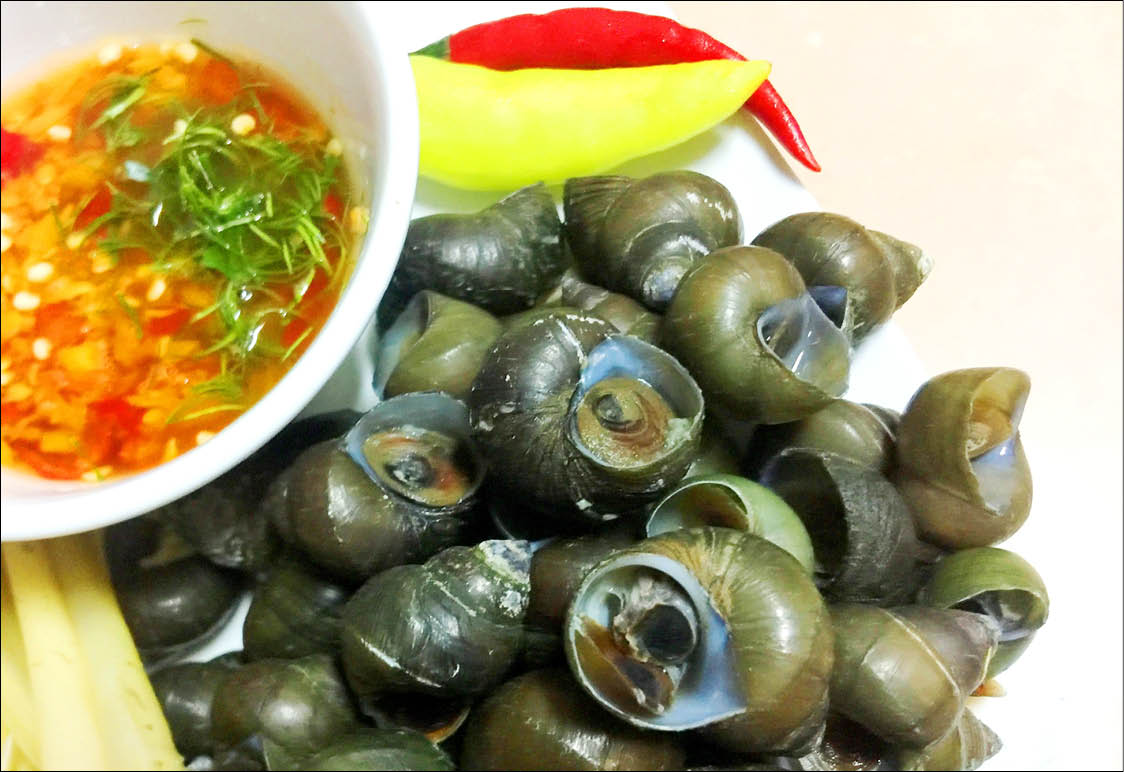
Big stream snails have a rich buttery taste and a slight bitter flavor
In the dreary November rain, baskets of fish and shrimps lined up along An Cuu River. The fishmongers sat shivering in their raincoats, raindrops falling on their tattered conical hats.
It began to rain more heavily, but it was a while until the riverbank became less crowded. Less crowded meant that there were still several baskets of river fish, of home-grown vegetables like green onions, starfruits, or figs. Mixed among them were baskets of snails, similar to regular snails but bigger, underneath the pouring rain.
I asked the seller why she didn’t go home and sell these snails tomorrow as they can live long and it was pouring. I told her she could catch a cold if she continued to sit there. I didn’t see clearly if she laughed or sighed. Through the rain, I saw her fingers, pale and frayed from soaking in the cold rain, stirring the snails in the basket as if inviting the buyer.
She didn’t get annoyed when I asked too many questions without having yet bought a single snail. "Sure, they’re snails, but these are not just any type of snails. They are “genuine” snails from Binh Dien. You can travel up to Nam Dong district, A Luoi, or even to Phu Loc, Phu Vang and you still cannot find snails like these. My little boy waded in the streams all morning to bring them home for me. If I take them back now, he would be really sad,” she said.
I asked her how to distinguish Binh Dien snails from other ones. “Just look at them and you can tell. These are twice, even three times as big as the snails sold in the restaurants. The shell is black green. They live in the mountain streams, eating moss and leaves so they are extremely tasty and clean. The easiest way to distinguish them is by their slightly bitter taste, like the twisted snails as long as the locust thorns which have gone extinct in our streams and rivers. I don’t mean to boast but those normal snails are no way near as good as these.”
There are Binh Dien stream snails all year round, but it is very laborious to catch them. So, you do not see them at the market every day. To prepare the snails, you must first soak them in rice water sprinkled with some chili powder so the snails will secrete all of their slime, making them less fishy. The snails live in the streams so they are fairly clean and don’t require much scrubbing force while washing.
Snails must, of course, be accompanied by lime leaves and lemongrass. Simply put, the dish is boiled snails. However, the name of the dish could also be a bit more embellished: steamed snails with lime leaves and lemongrass.
First, the lemongrass must be cleaned and cut into chunks, with the woody ends bashed. If you don’t have lime leaves, you can substitute with pomelo leaves. If you can’t find pomelo leaves, you can use some kumquat leaves from the tree displayed on Tet holiday 2 or 3 years ago. Pick some young leaves, wash them clean, and slice into thin strips. Mash some ginger and chili in a mortar. Add the lime leaves and ginger chili paste to some fish sauce. Gently stir to release the citrus oil. Boiled snails are not the same without the sauce.
Boiling the snails is quite straightforward. Put lemongrass on the bottom of the pot, pour the snails on top, throw in some lemongrass and fresh lime or pomelo leaves in, and pour in water until the snails are submerged. Wait until you can hear the boiling water and smell the aroma of lime leaves and lemongrass. Then, you can turn off your stove, take the snails out... and eat.
When your lips are red like wearing lipstick because of the ginger and chili, but your hand still reach for the snails, carefully using the locust thorn to gently pull out the fat snails to dip in the spicy sauce, don’t forget the pot of broth waiting on the stove.
Because Binh Dien stream snails are quite clean, the broth can be reheated, and served with some of the dipping sauce. When you are “taking a break” from the snails, try taking a sip of the steaming bowl of broth to taste the sweetness, the warmth, the spiciness, the conflict between putting the bowl down for some snails or continuing sipping the warm goodness that people may often criticize as tasteless...
Story and photos: Le Minh Trang